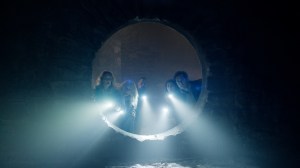In the grim and grinding early days of the Rebellion, where every act of defiance was a desperate gamble against the Empire’s tightening grip, the first act of rebellion by Luthen Rael happened on a world steeped in both Imperial evil and democratic hope. Star Wars: Andor Season 2, in its tenth episode, “Make it Stop,” delivered a quiet, almost understated bombshell that, for many, likely slipped by unnoticed. Way before the labyrinthine machinations of Luthen Rael’s thriving rebel cell, a scene unfolds that marks the beginning of Luthen’s direct, violent insurgency. But it’s not just the act itself that’s significant; it’s the location. Luthen, alongside a young and determined Kleya, orchestrates their first act of calculated terrorism on Naboo, a planet forever etched into the consciousness of Star Wars fans for its breathtaking beauty and its profound, often tragic, connections to the Skywalker saga.
Videos by ComicBook.com
This choice of setting is no mere coincidence; it is a meticulously crafted thematic statement, striking at the heart of Palpatine’s origins while simultaneously invoking the democratic spirit of Padmé Amidala; a spirit the Empire sought desperately to extinguish.
The Empire’s Vulnerability Was Exposed on Its Architect’s Home World as a Calculated Attack

Naboo, with its serene lakes, elegant architecture, and vibrant artistry, has always been the visual opposite of the drab, utilitarian Imperial aesthetic. Yet, beneath its tranquil surface lies the chilling reality that Naboo was the birthplace of Sheev Palpatine, the very architect of the galactic tyranny Luthen and Kleya sought to dismantle. For Luthen, a man who understands the power of symbolism as keenly as he does military tactics, striking on Naboo is an act of psychological warfare. It’s not merely about disrupting Imperial operations or inflicting casualties; it’s about sending a message directly to the Emperor, a declaration that no world, not even his cherished homeworld, is safe from the growing rebellion.
RELATED: Star Wars Finally Revealed the True Architect of the Rebellion
In an Q&A with Backstory Magazine, Andor screenwriter Tom Bissell discussed the choice to use Naboo as ground zero for Luthen’s rebellion.
“We knew we were gonna show their first act of terrorism. Kleya and Luthen together. And I argued it should be on Naboo, because that’s the Emperor’s home planet, and if Luthen is gonna make his first public statement, I think he’s gonna stick his thumb into the eye of the guy he hates more than anyone,” Bissell shared. “So Tony [Gilroy] heard my reasoning, he was like, ‘I like that, let’s do that.’ …So, it’s on Naboo. It’s their first act of terrorism, and it ends with Luthen blowing up this bridge and then walking away. Basically, the first thing he taught her – how to be an insurgent, right?”
Even where Luthen and Kleya position themselves to watch their attack unfold — an everyday cafe filled with ordinary citizens — amplifies the terror, illustrating that the Rebellion, in its early, unorganized form, is willing to sacrifice innocence to sow chaos and fear within the Empire’s seemingly impenetrable control. This act of terrorism, as the Empire would undoubtedly label it, is a direct challenge to the Imperial facade of absolute control and unwavering dominance; a deliberate defiling of the Emperor’s personal sanctuary. The very air of Naboo, once filled with the echoes of Gungan shouts and peaceful negotiations, now carries the metallic tang of rebellion’s first bitter taste. It’s a calculated attack, designed to rattle the very foundations of the Imperial psyche, demonstrating that the fight will be fought on any ground, even the sacred soil of the Emperor’s birth.
The Flame of Hope for Democracy Was Rekindled on the Planet of Its Greatest Champion

Beyond Palpatine’s legacy, Naboo is also synonymous with Padmé Amidala — a figure who, though sadly deceased by this point, remains a beacon of hope and an unwavering champion of democracy. Her entire life, from her spirited defense of Naboo against the Trade Federation to her tireless efforts in the Galactic Senate, was dedicated to preserving the Republic and its ideals. To launch an act of rebellion on Naboo, therefore, is to implicitly invoke her memory and the principles she embodied. It’s a stark reminder that even in the darkest of times, the spirit of resistance, the yearning for freedom and self-determination, can never be fully extinguished.
Luthen’s choice to have a young Kleya present, witnessing this pivotal moment, further emphasizes the passing of the torch, connecting the brutal realities of their two-person insurgency to the idealism that once flowed through Naboo’s veins. This isn’t only about destroying Imperial assets. It’s about reclamation; about reminding the galaxy that Naboo, despite its Imperial occupancy, still holds the spark of democratic fervor. The very act of rebellion, even a violent one, on this specific planet, speaks to the underlying yearning for the ideals that Padmé fought and died for. It’s a defiant whisper that echoes through the halls of galactic history: democracy, though wounded, is not dead, and its flame will be rekindled by any means necessary.
RELATED: Andor’s Surprise Ending for Its Big Villain Was Even More Twisted Than You Realized
The scene on Naboo, particularly given the planet’s history and idyllic image, serves to highlight the moral complexities and ambiguities of the early Rebellion. While the Empire is unequivocally evil, Luthen’s methods are often brutal and morally questionable. This choice of Naboo as Luthen’s first target forces viewers to confront the difficult questions woven into the very fabric of any revolutionary movement: What sacrifices are acceptable? What lines must be crossed to achieve freedom? Luthen and Kleya’s unwavering conviction shows the personal toll and ethical tightrope walked by those who dare to fight against an overwhelming tyranny. The beauty of Naboo, contrasted with the violence of Luthen’s attack on the bridge, creates a powerful visual metaphor for the dirty war being waged against the Empire, where even the most noble intentions can lead to unsettling consequences.
It’s a chilling reminder that the path to liberation is rarely clean, and often demands a descent into the very darkness one seeks to vanquish. The terrified screams and flurry of people running to seek safety on Naboo serve as a testament to the hard choices and the harsh realities faced by those who dared to ignite the fires of rebellion, even on a planet that symbolizes purity and peace.








